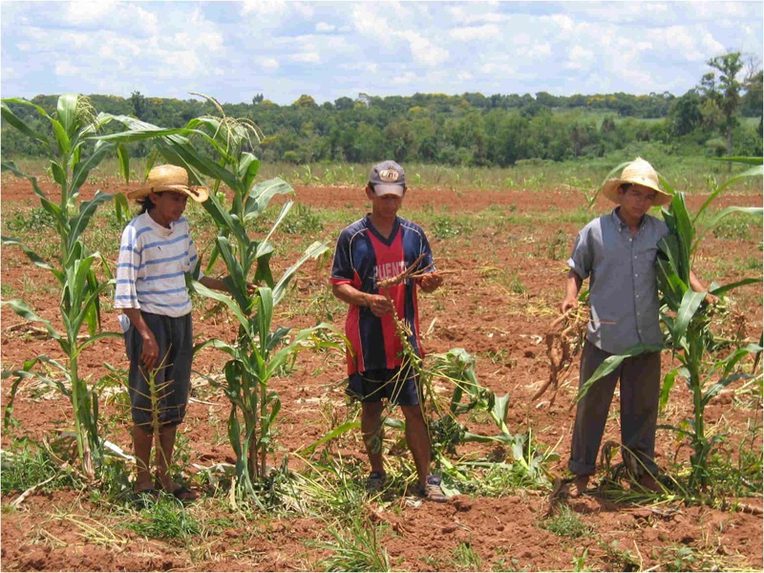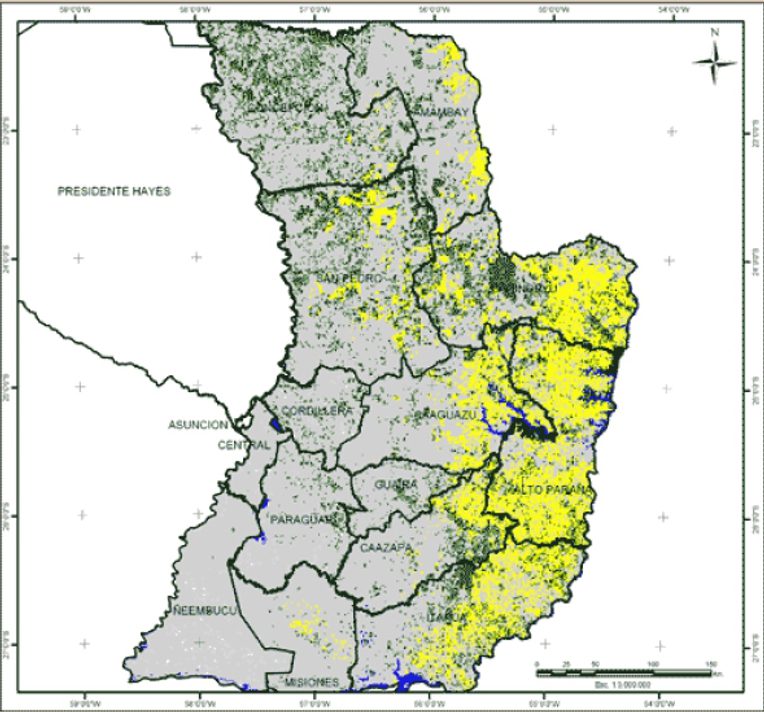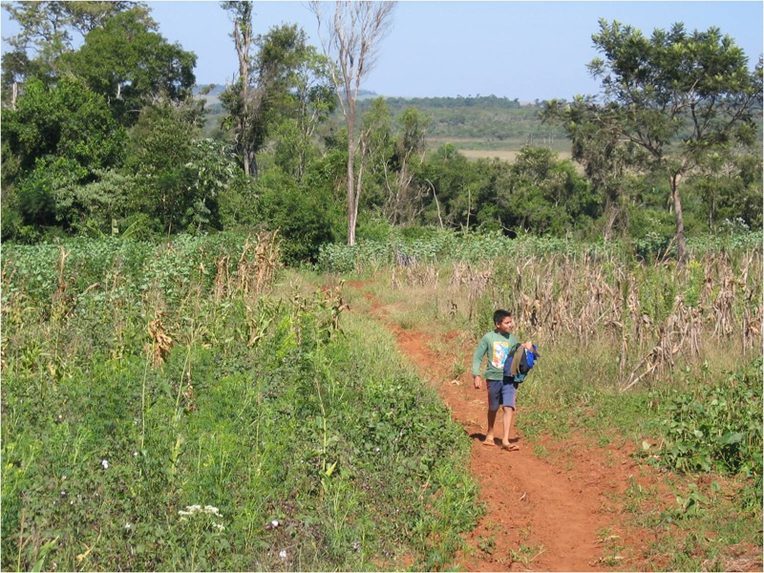This post builds on the research article “Beans Before the Law: Knowledge Practices, Responsibility, and the Paraguayan Soy Boom,” which was published in the February 2013 issue of the Society’s peer-reviewed journal, Cultural Anthropology.

Media from Article
From the author: The following series of pictures were part of a set of images that began to circulate in 2005 and 2006 as the two court cases detailed in this article began to take shape. Most of them were taken by me at the request of friends and informants around Vaqueria. Although dozens of my pictures made it into the hands of activists and journalists, these ones in particular travelled widely, and I am continually surprised by where I see them cropping up, in books, reports, in films, and especially on websites dealing with these issues.






Films about Soy:
Paraguay’s Painful Harvest. A film made for British television that is representative of the narrative that began to circulate internationally after 2006, largely due to the efforts of activists described in this article.
The Killing Fields. One of the better short films made by European activists about Paraguayan soy farming, including a section on Silvino Talavera.
The World According to Monsanto. A widely-seen film about genetically modified organisms and Monsanto’s production model, including an interview with Antonio Galeano’s brother, Jorge (at 1:42).
Websites with further links:
Toxic Soy. An English version of the same website, begun somewhat later.
Interview with Kregg Hetherington
Adonia Lugo: Your article posits that the ethnographer is part of the network of response and responsibility in the field. What are your thoughts on how ethnographic responsibility coheres away from the field?
Kregg Hetherington: Perhaps this will sound evasive, but I think this approach to responsibility undermines the separation of field from non-field, both analytically and ethically. Or perhaps it forces the ethnographer to imagine a field as co-constituted with responsibility, where the field is defined as that arena in which responses are playing out. The ethnographer’s audience, whatever kind of audience that may be, becomes enrolled in the responses. The writing of this article is very much part of the relationship I have with Antonio, with beans, and with others, and anyone who reads it also becomes part of that relationship, however passively.
During my dissertation work I came to the realization fairly quickly that at every stage of research I’ve been collecting and producing different kinds of documents, including press releases, court dockets, notarized photocopies of people’s ID cards, letters of introduction and request, consent forms, official testimonials, visa applications, fieldnotes, photographs, books, lecture slides. And since I thought of most of the documents I dealt with in pragmatic terms, there was no reason to think of my academic writing (or reading) in any other way. Despite the very different forms these documents take, each one of them is explicitly aimed at articulating relationships around the situation I’m at such pains to analyze here. Finding my place in that constantly shifting set of relationships, which include the micro-political interactions in Paraguay and my own attempt to build a career in the academy, is constantly on my mind, but I rarely find myself thinking in terms of a definable field.
The rider to that is that the very attenuate sense of responsibility that I outline in this article in relation to beans applies across the board to anthropology. There are moments during and after research when any researcher feels that very specific actions or acts of representation were likely to have effects that they think of as good (in my case, for example testifying in court or speaking to journalists, and allowing activists to use pictures that I took). But these are rare, and even then rarely play out the way you think they will. That’s why I’m skeptical of forms of activist academia that base their methods or ethics on an exaggerated, often heroic sense of responsibility, in the sense of simplified, intentional causal claims about individual acts of knowledge production.

AL: Do you see yourself as a spokesperson for your interlocutors in the English speaking world? Do you think your interlocutors see you that way?
KH: Mainly no. No in the sense that it is not my primary intention to speak or translate for others, but rather to extend discussion of a situation, adopting those modes of attention and analysis that I think are appropriate to that situation, and that have some traction in the academic networks where my work is discussed, mostly in Canada, the US, Europe and Latin America. But I also can’t deny that at moments certain of my interlocutors wished that I would be more like a straightforward translator of their political aims, and that their openness with me was in part based on that desire. Many of my friends in rural Paraguay see my book as somehow “getting their story out” to the international sphere, no matter what I say about it, and at times I find the pressure to write in a certain way quite strong.
In a sense, the arrival, part-way through my research, of a number of international activists into the network I was part of, made this all clearer. As many anthropologists do, I found myself very pressured to write the kind of propagandistic work that I thought was ethnographically untenable, and it forced me to clarify for myself and others what the difference was between my work and theirs. That was a great relief in some respects. The activists took over that role, and very ably began to produce the kind of sensationalist journalism for international consumption that Antonio and others wished I might produce. It gave me some room to find an ethnographic voice rather than an activist one, one in which I am a spokesperson in the Latourian sense, for a situation rather than for people in particular. Some of that more journalistic activism is posted here, and I for the most part have not been actively involved in creating it.
AL: You share your initial hesitation to consider the soybeans actors, then explain how Antonio's perspective pushed you to investigate knowledge practices associated with the beans. This seems like a great example of being open to interlocutors' frameworks and moving in a different direction than you expected. Is that what happened in this case?
KH: Part of my discussion of response here is about trying to articulate this vision of ethnography without claiming to merely adopt a particular perspective, or to speak for, or worse “give voice to” particular people. It’s about allowing a situation to get under one’s skin, allowing oneself to be deeply moved by the complexity of human experience and knowledge and to try to articulate an analysis that does justice to that complexity. I really think this is still what ethnography does best. It’s certainly what I find most rewarding, intellectually and personally, about this kind of research.
AL: I'd be interested to hear more about your choice to use response rather than agency. Certainly the latter is a term whose ubiquity makes its utility questionable, but I'm curious if you're also trying to avoid a simplistic "resistance" model of peasant activism.
KH: Ten years ago, when I began this work, I really felt like the resistance model, as you call it, still weighed heavily in the discipline, particularly when talking about peasants in Latin America. So I’ve struggled with that a lot, because I continue to be very much in conversation with that literature, even though I start from a different theoretical position. But being in conversation with that literature also puts the onus on one to justify the theoretical language that’s more current in STS. When I did use agency as opposed to resistance to describe this work, I often found myself either being dismissed, or spending too much time defending that language.
What that discussion forced me to do was to realize that, even if I had no problem with the ontological premises of a Latourian notion of “agency,” the term was dissatisfying for what I wanted to talk about. It was too flat, and didn’t force one to account for the responsibility of the analyst. Karen Barad’s work was really helpful to me here, and for a while I was using her idea of the “agential cut” to describe the moment of analytic separation that makes agency possible. But that still didn’t solve the problem of theoretical separation; there was still something rarified about the vocabulary that meant that the discussions I had about the term peel away from the ethnographic situation. I wanted to try to do the same thing with a word that evokes politics and ethics and law, that sounds commonplace, and that, when one really thinks about it, is enormously rich in its everyday usage. It opened up a much richer set of questions for me, about how we approach the powerful objects around us analytically and politically.

AL: Including oneself as an activist in ethnographic work is tricky business. I think your explanation of how you had been activated in a network makes a lot of sense. Did your position in your interlocutors' efforts make certain other relationships in the field (such as with Brasiguaios) complicated or impossible?
KH: Yes, and that has affected my ability to do research since then as well, which is often frustrating. But I also think this is part of what all fieldwork does. As you develop relationships with people, you make allies and enemies, confidants who can sway you and others who can undermine you. In my case it’s perhaps extreme, in the sense that I became a relatively visible enemy, for a time, of many of the people I wanted to talk to. By the same token, the fact that I felt it necessary to take sides in a dispute like this intensified my relationships with others, deepened our mutual trust and my sense of responsibility in the events I was living through. Given the extreme animosities I was living amongst it seemed both unwise and untenable to be the only person around who claimed not to have an opinion, and it was unrealistic to expect people to appreciate what I saw as the nuances of my position.
But as I said, if in this case the dynamic was particularly extreme, I don’t think it was unusual, nor do I think it’s just a problem of “activist” anthropology. Like it or not, all anthropologists produce knowledge while situated in a field of differential and agonistic relationships. All analysis involves side-taking, and the degree to which people agree or not can have as much to do with how invested people are in the topic as it does with empirical accuracy. Particularly when you write about politics, there are always lots of people who don’t like what you have to say; that’s just the nature of the beast. If everyone likes a particular perspective it’s undoubtedly because that perspective only engages with the tritest of generalities. That is genuinely irresponsible, not in that it causes bad things to happen, but in that it refuses to recognize academic work as part of the chain of responses. The encounter with Andres that I describe at the beginning of the article is very much a description of a naive ethnographer trying not to offend. But now I really think ethnography should be offensive, or at least should not be afraid of being offensive. It makes it possible to say much more interesting things.
AL: Are you continuing with work in Paraguay, or following these threads in some other context?
KH: My current project, which really began with this essay, is trying to get a handle on the Paraguayan state’s regulatory response to the soy boom. I felt it was a necessary next step because in much of my work I’ve been very critical of regulatory actors and in particular of well-meaning social democrats and development experts in Asuncion. In 2008, in part because of the struggles I describe here, there was an unprecedented change in government that brought those social democrats to power for the first time. Their government was propped up by campesino organizations, and had as one of its primary mandates an attempt to seriously regulate the soy sector. So since then I have been working primarily with functionaries of the new regulatory agencies that were constructed under that government, asking how one can think of the state as response. The state really looms large in the Latin American political imaginary, but what I love about this project is seeing the state at its most tentative, trying to forge expertise, scientific authority and working legal frameworks through tentative acts of relationship-building and intervention, in a contentious situation saturated with international capital, private science, overwhelmingly complex social and environmental changes and sporadic eruptions of violence.
Discussion Questions
1. Hetherington commented that the arrival of international activists in his field site gave him "some room to find an ethnographic voice rather than an activist one, one in which I am a spokesperson in the Latourian sense, for a situation rather than for people in particular." What are some expectations you might encounter in the field, from interlocutors or collaborators, and how would you navigate them?
2. The concepts of response and responsibility acknowledge the fact that fieldworkers are part of others' networks. Map the networks an ethnographer might assemble, placing yourself at the center.
3. Even if we would prefer to stay out of controversy, people expect anthropologists to have opinions, as Hetherington noted. Have you encountered a situation where you disagreed with your interlocutors or others? How does one write respectfully about this after the fact?